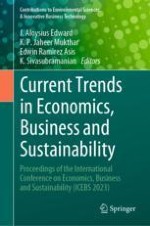2023 | Buch
Current Trends in Economics, Business and Sustainability
Proceedings of the International Conference on Economics, Business and Sustainability (ICEBS 2023)
herausgegeben von: J. Aloysius Edward, K. P. Jaheer Mukthar, Edwin Ramirez Asis, K. Sivasubramanian
Verlag: Springer Nature Singapore
Buchreihe : Contributions to Environmental Sciences & Innovative Business Technology
